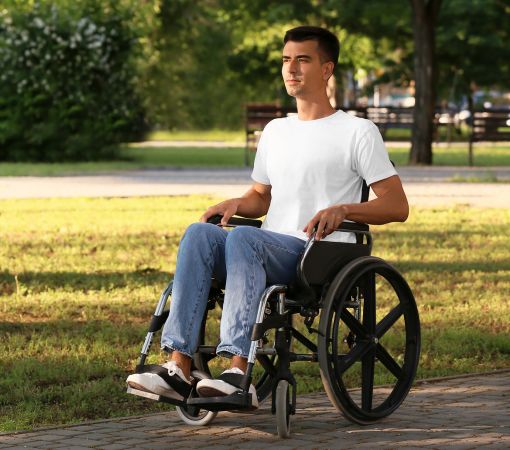Spine Surgeon
Paralysis Doctor Mumbai
Paralysis / Paraplegia
Paraplegia is a form of paralysis involving the loss of motor function in the lower half of the body, typically caused by spinal cord injury or disease. It results in the inability to move or control the legs, impacting mobility and daily activities. Medical interventions, including surgery or medication, may be employed depending on the underlying cause.
What Are the Causes and Symptoms of Paraplegia?
Causes of Paraplegia:
- Spinal Cord Injury: Trauma to the spinal cord, often resulting from accidents, falls, or sports injuries, can cause paraplegia.
- Diseases: Certain medical conditions, such as spinal tumors, multiple sclerosis, or transverse myelitis, can lead to damage or compression of the spinal cord.
- Infections: Infections affecting the spinal cord, like meningitis or abscesses, may result in paraplegia.
- Vascular Issues: Reduced blood supply to the spinal cord due to conditions like strokes or arterial blockages can cause paralysis.
- Congenital Conditions: Some individuals may be born with conditions affecting spinal cord development, leading to paraplegia.
Symptoms of Paraplegia:
- Loss of Motor Function: Inability to move or control the legs and lower body.
- Loss of Sensation: Diminished or complete loss of sensation in the lower extremities.
- Impaired Bowel and Bladder Control: Paraplegia often involves challenges with controlling bowel and bladder functions.
- Spasticity or Muscle Stiffness: Increased muscle tone and stiffness in the affected areas.
- Changes in Sexual Function: Paraplegia may impact sexual function and fertility.
- Chronic Pain: Individuals with paraplegia may experience chronic pain, often related to nerve damage.
- Limited Mobility: Dependence on assistive devices like wheelchairs for mobility.
How to diagnose paraplegia?
Clinical Assessment: A thorough medical history and physical examination are conducted to understand the onset, progression, and potential causes of paraplegia. Neurological assessments evaluate reflexes, sensation, and muscle strength.
Imaging Studies: Imaging techniques such as X-rays, CT scans, or MRI are utilized to visualize the spinal cord, vertebrae, and surrounding structures. These tests help identify injuries, tumors, or abnormalities causing paraplegia.
Electrodiagnostic Tests: Electromyography (EMG) and nerve conduction studies may be performed to assess electrical activity in muscles and nerves, helping to pinpoint the location and extent of nerve damage.
Blood Tests: Blood tests may be conducted to rule out systemic conditions or infections that could contribute to paraplegia. These tests help in identifying potential underlying causes.
Lumbar Puncture: In some cases, a lumbar puncture (spinal tap) may be performed to analyze cerebrospinal fluid for signs of infection, inflammation, or bleeding affecting the spinal cord.
Genetic Testing: For congenital or hereditary causes of paraplegia, genetic testing may be recommended to identify specific genetic mutations or conditions.
Specialized Tests: Depending on the suspected cause, additional specialized tests such as angiography, myelography, or biopsy may be conducted to gather more detailed information.
What are the complications of paraplegia?
- Sensory Loss: Paralysis results in the loss of sensation, affecting touch, temperature, and pain perception.
- Mobility Challenges: Paralyzed individuals face difficulties in walking, standing, and performing daily activities independently.
- Bowel and Bladder Dysfunction: Paralysis can lead to impaired control over bowel and bladder functions, requiring management.
- Respiratory Issues: Depending on paralysis extent, respiratory muscles may be affected, leading to breathing difficulties.
- Pressure Sores: Immobility increases the risk of pressure sores, particularly in areas like the buttocks and heels.
What is the treatment for paraplegia?
Medications:
Depending on the underlying cause, medications may be prescribed to manage symptoms, alleviate pain, or address specific conditions contributing to paraplegia.
Assistive Technologies:
- Wheelchairs and Mobility Aids: Customized wheelchairs and mobility devices enhance independent movement.
- Orthotic Devices: Braces or orthotic devices may be used to support and stabilize affected limbs.
- Communication Aids: Devices such as voice-activated technology assist individuals with limited mobility in communication.
Functional Electrical Stimulation (FES):
FES uses electrical currents to stimulate paralyzed muscles, aiding in muscle contraction and functional movement.
Continued Monitoring and Follow-Up:
Regular medical check-ups and ongoing rehabilitation assessments ensure that the treatment plan is adjusted based on the individual’s progress and evolving needs.
What are the surgical interventions for paraplegia?
- Laminectomy
- Discectomy
- Spinal stabilization
- Spinal Fusion
- Foraminotomy
- Intrathecal Baclofen Pump
- Implantation
- Peripheral Nerve Surgery
- Spinal Cord Stimulation
Synapse Spine hospital in Mumbai provides specialized care for Paralysis Doctor Mumbai ,India , offering innovative treatments tailored to individual needs. With a commitment to excellence, Synapse Spine strives to empower patients with expert support and personalized solutions for paralysis.

